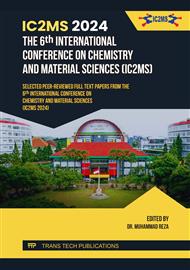[1]
A. R. Wijaya et al., "Road-side dust from central Jakarta, Indonesia: Assessment of metal(loid) content, mineralogy, and bioaccessibility," Environ. Technol. Innov., vol. 28, p.102934, Nov. 2022.
DOI: 10.1016/j.eti.2022.102934
Google Scholar
[2]
A. R. Wijaya, F. Khoerunnisa, A. Armid, and R. A. Lusiana, "The best-modified BCR and Tessier with microwave-assisted methods for leaching of Cu/Zn and their δ 65 Cu/ δ 66 Zn for tracing sources in marine sediment fraction," Environ. Technol. Innov., vol. 28, p.102663, Nov. 2022.
DOI: 10.1016/j.eti.2022.102663
Google Scholar
[3]
A. R. Wijaya et al., "Analysis of Fe in Sediment Material using a Modified Tessier Technique for Detection of Fe-Anthropogenic and Fe-Naturals," IOP Conf. Ser. Mater. Sci. Eng., vol. 515, p.012015, Apr. 2019.
DOI: 10.1088/1757-899X/515/1/012015
Google Scholar
[4]
S. Rasheed et al., "Salt Intake and Health Risk in Climate Change Vulnerable Coastal Bangladesh: What Role Do Beliefs and Practices Play?" PLOS ONE, vol. 11, no. 4, p. e0152783, Apr. 2016.
DOI: 10.1371/journal.pone.0152783
Google Scholar
[5]
H. Nassrullah, S. F. Anis, R. Hashaikeh, and N. Hilal, "Energy for desalination: A state-of-the-art review," Desalination, vol. 491, p.114569, Oct. 2020.
DOI: 10.1016/j.desal.2020.114569
Google Scholar
[6]
D. Curto, V. Franzitta, and A. Guercio, "A Review of the Water Desalination Technologies," Appl. Sci., vol. 11, no. 2, p.670, Jan. 2021.
DOI: 10.3390/app11020670
Google Scholar
[7]
H. Fuadi Sujoko Putra, A. Alfarisyi Syah, and A. Ricky Wijaya, "Application of Calcium Alginate Products for Seawater Desalination Process," E3S Web Conf., vol. 481, p.03010, 2024.
DOI: 10.1051/e3sconf/202448103010
Google Scholar
[8]
A. Benhouria, Md. A. Islam, H. Zaghouane-Boudiaf, M. Boutahala, and B. H. Hameed, "Calcium alginate–bentonite–activated carbon composite beads as highly effective adsorbent for methylene blue," Chem. Eng. J., vol. 270, p.621–630, Jun. 2015.
DOI: 10.1016/j.cej.2015.02.030
Google Scholar
[9]
A. Gonzalez-Pujana, G. Orive, J. L. Pedraz, E. Santos-Vizcaino, and R. M. Hernandez, "Alginate Microcapsules for Drug Delivery," in Alginates and Their Biomedical Applications, vol. 11, B. H. A. Rehm and M. F. Moradali, Eds., in Springer Series in Biomaterials Science and Engineering, vol. 11. , Singapore: Springer Singapore, 2018, p.67–100.
DOI: 10.1007/978-981-10-6910-9_3
Google Scholar
[10]
S. H. Ching, N. Bansal, and B. Bhandari, "Alginate gel particles–A review of production techniques and physical properties," Crit. Rev. Food Sci. Nutr., vol. 57, no. 6, p.1133–1152, Apr. 2017.
DOI: 10.1080/10408398.2014.965773
Google Scholar
[11]
B. Wang et al., "Alginate-based composites for environmental applications: a critical review," Crit. Rev. Environ. Sci. Technol., vol. 49, no. 4, p.318–356, Feb. 2019.
DOI: 10.1080/10643389.2018.1547621
Google Scholar
[12]
S. Wu et al., "Adsorption Properties of Doxorubicin Hydrochloride onto Graphene Oxide: Equilibrium, Kinetic and Thermodynamic Studies," Materials, vol. 6, no. 5, p.2026–2042, May 2013.
DOI: 10.3390/ma6052026
Google Scholar
[13]
M. Yadav, K. Y. Rhee, and S. J. Park, "Synthesis and characterization of graphene oxide/carboxymethylcellulose/alginate composite blend films," Carbohydr. Polym., vol. 110, p.18–25, Sep. 2014.
DOI: 10.1016/j.carbpol.2014.03.037
Google Scholar
[14]
S. M. Elgengehi, S. El-Taher, M. A. A. Ibrahim, J. K. Desmarais, and K. E. El-Kelany, "Graphene and graphene oxide as adsorbents for cadmium and lead heavy metals: A theoretical investigation," Appl. Surf. Sci., vol. 507, p.145038, Mar. 2020.
DOI: 10.1016/j.apsusc.2019.145038
Google Scholar
[15]
I. Ali et al., "Graphene based adsorbents for remediation of noxious pollutants from wastewater," Environ. Int., vol. 127, p.160–180, Jun. 2019.
DOI: 10.1016/j.envint.2019.03.029
Google Scholar
[16]
N. Suwannasingha, A. Kantavong, S. Tunkijjanukij, C. Aenglong, H.-B. Liu, and W. Klaypradit, "Effect of calcination temperature on structure and characteristics of calcium oxide powder derived from marine shell waste," J. Saudi Chem. Soc., vol. 26, no. 2, p.101441, Mar. 2022.
DOI: 10.1016/j.jscs.2022.101441
Google Scholar
[17]
S. Soisuwan, J. Phommachant, W. Wisaijorn, and P. Praserthdam, "The Characteristics of Green Calcium Oxide Derived from Aquatic Materials," Procedia Chem., vol. 9, p.53–61, 2014.
DOI: 10.1016/j.proche.2014.05.007
Google Scholar
[18]
S. Ahmed, T. R. Choudhury, Md. Z. Alam, and M. Nurnabi, "Characterization and application of synthesized calcium alginate-graphene oxide for the removal of Cr3+, Cu2+ and Cd2+ ions from tannery effluents," Clean. Water, vol. 1, p.100016, Jun. 2024.
DOI: 10.1016/j.clwat.2024.100016
Google Scholar
[19]
T. D. T. Oyedotun, "X-ray fluorescence (XRF) in the investigation of the composition of earth materials: a review and an overview," Geol. Ecol. Landsc., vol. 2, no. 2, p.148–154, Apr. 2018.
DOI: 10.1080/24749508.2018.1452459
Google Scholar
[20]
V. Ramasamy, P. Anand, and G. Suresh, "Synthesis and characterization of polymer-mediated CaCO3 nanoparticles using limestone: A novel approach," Adv. Powder Technol., vol. 29, no. 3, p.818–834, Mar. 2018.
DOI: 10.1016/j.apt.2017.12.023
Google Scholar
[21]
Z. Mirghiasi, F. Bakhtiari, E. Darezereshki, and E. Esmaeilzadeh, "Preparation and characterization of CaO nanoparticles from Ca(OH)2 by direct thermal decomposition method," J. Ind. Eng. Chem., vol. 20, no. 1, p.113–117, Jan. 2014.
DOI: 10.1016/j.jiec.2013.04.018
Google Scholar
[22]
C. Matei, D. Berger, A. Dumbrava, M. D. Radu, and E. Gheorghe, "Calcium carbonate as silver carrier in composite materials obtained in green seaweed extract with topical applications," J. Sol-Gel Sci. Technol., vol.93, no. 2, p.315–323, Feb.2020.
DOI: 10.1007/s10971-019-05145-6
Google Scholar
[23]
T. E, D. Ma, S. Yang, and X. Hao, "Graphene oxide-montmorillonite/sodium alginate aerogel beads for selective adsorption of methylene blue in wastewater," J. Alloys Compd., vol. 832, p.154833, Aug. 2020.
DOI: 10.1016/j.jallcom.2020.154833
Google Scholar
[24]
B. Gunes et al., "Activated Graphene Oxide-Calcium Alginate Beads for Adsorption of Methylene Blue and Pharmaceuticals," Materials, vol. 14, no. 21, p.6343, Oct. 2021.
DOI: 10.3390/ma14216343
Google Scholar


